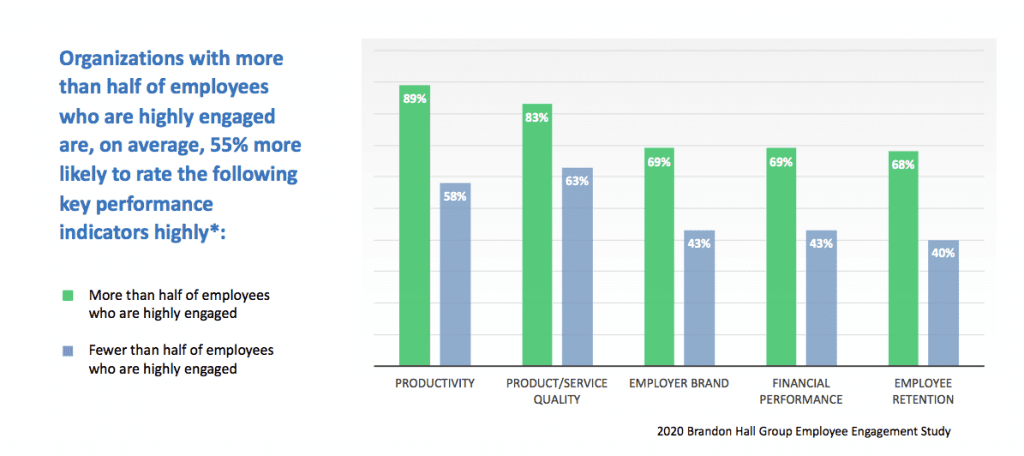There are few issues more disheartening and frustrating for managers than employee disengagement. A team member who’s lost their spark can bring down the entire team. Moreover, it feels like a personal failure for managers.
Employee disengagement is a personal subject, but it’s also a universal one, with enormous financial costs.
According to 2017 research by Deloitte, American businesses spend over $1 billion a year on employee engagement in the form of surveys, initiatives, and programs. It’s a staggering number, but it’s just the tip of the iceberg when we consider what disengagement costs businesses in the form of turnover and lost productivity.
It’s critical for managers to understand the true cost of employee disengagement, so we want to give the issue the attention it deserves. Here, we’ll define the issue and its costs, as well as tips for getting your team engaged again.
What Is a Disengaged Employee?
You can define a disengaged employee as someone whose enthusiasm, attitude, and work quality have all declined. A disengaged employee is different from a merely “bad” employee or someone who has been apathetic since day one. Disengagement is a loss of motivation and satisfaction, but what it looks like varies from person to person. A high-performer may still be doing “fine” when disengaged, but they’ve stopped growing and aren’t living up to their potential.
Of course, you can’t define disengagement without defining engagement, but there’s no clear consensus on what an engaged employee looks like. In a 2020 Brandon Hall study, respondents were pretty evenly split over seven definitions, ranging from emotional commitment, happiness, willingness to do their best work, and impacting business results.
Deloitte, meanwhile, closely links engagement to “the passion of the explorer.” By this, they mean a drive to seek out challenges and make a big impact. (Discouragingly, Deloitte concludes that only 13% of workers have this passion, but let’s respectfully disagree and move on.)
For our purposes, we can place engagement at the center of a Venn diagram containing happiness, rewarding challenges and growth opportunities, and investment in the team and the company.
So how do you know when an employee is disengaged?
It can be difficult for managers to spot disengaged employees because they’re usually sleeping under their desks.
(That was a joke.)
In all seriousness, it’s incredibly important for managers to be able to recognize the warning signs of disengagement. Turning in late work goes from a rare event to a weekly occurrence. They stop speaking up and sharing ideas. They stop taking ownership of their work and start counting down the minutes until they can clock out. In the final stage, a disengaged employee will suddenly start sporting a revamped LinkedIn profile and an interview-ready haircut. But if you’ve waited that long to do something, it’s probably too late.
Would you like to boost productivity, increase trust and have a healthier, happier team?
Download your FREE 1:1 guide now!
Why Do Employees Become Disengaged?
Employees become disengaged when their work life feels stagnant. Their work feels repetitive, they don’t believe they can make an impact on the organization, and their workplace relationships lack depth.
Gallup research has found that workers have the highest engagement during the first six months of a new job, after which it falls off and rarely recovers. Is this just a honeymoon period, like the beginning of a new relationship, when everyone pretends to be into hiking and going to museums?
To some extent it is, but those first six months are also the time when your team members face the toughest challenges and have the highest hopes. They’re eager to prove themselves and eager to believe that their skills will be recognized and rewarded.
The problem is that once your team members get comfortable in their duties, they’re no longer challenged by them.
After six months, a team member’s initial high hopes often give way to disappointment. Team members want to believe in the company but often find that the culture is resistant to change, so it feels pointless to try. Team members crave meaningful relationships but don’t get enough personal attention from their manager. In these circumstances, there’s no place for a team member’s passion to go, so it simply dissipates.
To be blunt, most employees stop giving their heart, soul, and attention to their job because their job doesn’t earn it.
But your team members want to be engaged! We spend the majority of our lives at work, and most of us would rather spend that time striving to excel instead of doing the bare minimum. The overwhelming majority of “passionate” and “contented” employees in Deloitte’s survey reported that they “welcome opportunities to try new tasks” and are excited by new challenges. It’s just that they rarely get the chance.
The problem is widespread. In 2015, Gallup reported that employee engagement was at a three-year high…of 32.9%. (After 2015, Gallup was apparently stricken by its own case of ennui and stopped studying engagement.)
How Much Do Disengaged Employees Cost Businesses?
The costs of employee disengagement are nothing short of staggering, even though many of them are hidden from view.
As discussed above, in 2017, Deloitte found that American companies spend $1 billion directly on engagement, “and over $100 billion on training and development activities.”

We can also measure the cost of disengagement in terms of turnover and productivity. Disengaged employees are much more likely to seek employment elsewhere, which is enormously costly. Estimates vary widely of how much employee turnover costs, but for professional and technical roles, the cost can range from 75-150% of the annual salary.
Then there’s productivity. As a manager, you’ve probably observed that disengaged employees are more prone to make costly errors and drop the ball for customers. Gallup has estimated that companies that rank high in employee engagement have 20% greater productivity, 21% greater profitability, and 10% greater customer loyalty than low-engagement companies. Brandon Hall’s research echoes these findings.

Source
Turnover and productivity are all quantifiable metrics. But what’s less visible, though no less costly, is lost potential. When employees disengage, they stop collaborating and sharing knowledge. They’re not motivated to come up with new ideas that could improve efficiency. They no longer seek out promotion or growth opportunities, so it becomes impossible to build your team.
How Managers Can Help Disengaged Employees
Businesses go to great expense to increase employee engagement, but it’s not the kind of problem you can just throw money at.
Addressing employee disengagement requires consistent, personalized investment from managers.
Manager, motivate thyself
Deloitte found that half of executives and senior management are neither passionate nor engaged. It should go without saying, but if you can’t model enthusiasm, don’t expect to see it in your team. Luckily, you have a job worth being passionate about! Redouble your commitment to your team’s success and to improving your company’s culture.
Address the problem head-on
If you notice the tell-tale signs of a disengaged employee, don’t just privately hope it will go away on its own. Tell them your concerns in a one-on-one meeting. However, it’s crucial that you’re curious instead of accusatory. Ask questions about what’s missing in this person’s work life and what you can do to provide it.
Sometimes, disengagement is just a brief dip from which an employee will recover, so don’t overreact. But don’t beat around the bush either.
Provide challenges and growth
Don’t let your team get bored and stagnant! Set regular professional development goals to keep people learning. Brandon Hall found that organizations that rank high for career development are 2.25 times more likely to have highly engaged teams.
You can tailor these goals to an employee’s level of motivation. Put a high-performing team member on the path to promotion, nurture someone else’s interest by having them learn a new piece of software, and get a third back on track by setting goals for improved timeliness and communication.
When possible, trust your team members enough to nudge them to new things. Let someone run a meeting, take point on a customer call, or step up in some way that pushes them outside their comfort zone. They might not thank you at the moment, but you’ll still see that glint of passion come back into their eyes as they strive toward a new goal.
Recognize achievement
It’s very difficult for a team member to be engaged if they feel ignored. And if an employee feels challenged but not supported, they might get disgruntled rather than engaged. So it’s vital to take the time to celebrate small wins, both in private and in front of the team.
Well-earned praise from a manager increases a team member’s happiness quotient, and just as importantly, it reminds them that they matter.
Connect their success to the success of the team and the company, and they’ll be more invested in both.
Build strong relationships
If you want to unlock your team’s passion and dedication to their work, you have to create an environment in which work feels meaningful. For most businesses, that means having rich relationships in which team members are accountable to each other and support each other.
To build strong, trusting relationships, you need to seek out your team’s feedback. Disengagement happens when team members feel like nothing they say will make a difference in the workplace. Prove them wrong by listening to their ideas and putting them in action whenever possible.
Don’t Give up on Disengaged Employees
Employee disengagement is such a widespread and costly problem that it’s easy for managers to just give up and write team members off as lost causes. But remember, employee disengagement isn’t a character flaw; it’s a symptom of other problems in the workplace.
As a manager, you have the power and the tools to get your team engaged again. It can start at your next one-on-one.
Download your FREE Ultimate Guide to 1:1s
Learn how to have productive and meaningful conversations and boost productivity, increase trust and have a healthier, happier team!


